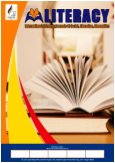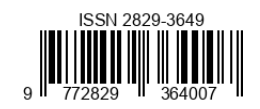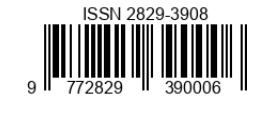Efforts to Improve Student Learning Outcomes through the Think Pair Share Type Cooperative Learning Model on the Theme of Clean Air for Health in Class V of SD Negeri 101948 Bingkat
DOI:
https://doi.org/10.56910/literacy.v4i2.2243Keywords:
Class V, Elementary Education, Student Learning OutcomesAbstract
This study aims to decide the application of the think pair share type cooperative learning model on the theme of clean air for health in grade V elementary school students. This study is a classroom action study with the Kemmis and McTaggart model with descriptive analysis. This research was conducted in grade V of SD Negeri 101948 Bingkat, Pegajahan District, Serdang Bedagai Regency. The participants in this study were grade V teachers and grade V students of SD Negeri 101948 Bingkat totaling 31 students. The data collection techniques used are observation, interviews, and documentation. The stages of data analysis are planning, acting, seeing, and reflecting. Based on the results of research that has been carried out using the think pair share type cooperative learning model on the theme of clean air for health in grade V of SD Negeri 101948 Bingkat, it shows that student learning activities have reached 93% in the Very Good category. The student's ability to solve pre-test questions has been completed. Based on the calculation of student learning outcomes, there were 3 students who got very high scores, 23 students who got high scores, 3 students who got enough scores, and 2 students who got low scores. Of the 31 students, 29 students have completed their studies.
References
[1] F. N. Ichsan, “Implementasi Perencanaan Pendidikan dalam Meningkatkan Karakter Bangsa Melalui Penguatan Pelaksanaan Kurikulum,” Al-Riwayah : Jurnal Kependidikan, vol. 13, no. 2, pp. 281–300, Oct. 2021, doi: 10.47945/AL-RIWAYAH.V13I2.399.
[2] M. C. Mawardi, “Tingkat Pemahaman Mahasiswa Akuntansi terhadap Konsep Dasar Akuntansi di Perguruan Tinggi Negeri di Kota Malang,” IQTISHODUNA, vol. 8, no. 1, Apr. 2012, doi: 10.18860/IQ.V0I0.1758.
[3] M. A. Sanjani, “Tugas dan Peranan Guru dalam Proses Peningkatan Belajar Mengajar,” Serunai : Jurnal Ilmiah Ilmu Pendidikan, vol. 6, no. 1, pp. 35–42, Jun. 2020, doi: 10.37755/SJIP.V6I1.287.
[4] S. A. Reza and D. Nora, “Penggunaan Media Internet Sebagai Sumber Belajar di Kalangan Peserta Didik Kelas XII IPS di SMA Pertiwi 1 Padang Pada Masa Pandemi Covid-19,” Naradidik: Journal of Education and Pedagogy, vol. 1, no. 1, pp. 11–19, Jan. 2022, doi: 10.24036/NARA.V1I1.4.
[5] Hidayat, Sukmawarti, and N. Fadilah, “Upaya Meningkatkan Aktivitas dan Hasil Belajar Siswa Kelas 5 SD dengan Menggunakan Chip Bilangan,” JS (JURNAL SEKOLAH), vol. 6, no. 4, pp. 160–167, Sep. 2022, doi: 10.24114/JS.V6I4.38854.
[6] Jumarniati and A. Anas, “Pengaruh Motivasi Belajar dan Aktivitas Belajar terhadap Hasil Belajar Mahasiswa Program Studi PGSD,” Cokroaminoto Journal of Primary Education, vol. 2, no. 2, pp. 41–47, Oct. 2019, doi: 10.30605/CJPE.222019.113.
[7] F. Khaulani, Neviyarni, and Irdamurni, “Fase dan Tugas Perkembangan Anak Sekolah Dasar,” Jurnal Ilmiah Pendidikan Dasar, vol. 7, no. 1, pp. 51–59, Jan. 2020, doi: 10.30659/PENDAS.7.1.51-59.
[8] T. Depita, “Pemanfaatan Teknologi Dalam Pembelajaran Aktif (Active Learning) Untuk Meningkatkan Interaksi dan Keterlibatan Siswa,” Tarqiyatuna: Jurnal Pendidikan Agama Islam dan Madrasah Ibtidaiyah, vol. 3, no. 1, pp. 55–64, Aug. 2024, doi: 10.36769/TARQIYATUNA.V3I1.516.
[9] J. Y. Harahap, R. Hayati, and D. Yarshal, “Pengaruh Self Efficacy dalam Belajar pada Mahasiswa Melalui Model Pembelajaran Diskusi Kelompok,” Jurnal Pendidikan Tambusai, vol. 5, no. 3, pp. 7828–7833, Nov. 2021, doi: 10.31004/JPTAM.V5I3.2249.
[10] R. A. Amar and D. Yarshal, “Penerapan Model Cooperative Learning Tipe Time Token untuk Meningkatkan Kepercayaan Diri Siswa pada Tema Daerah Tempat Tinggalku di Kelas IV SD Negeri 101893 Bangun Rejo Kecamatan Tanjung Morawa,” Jurnal Inovasi Penelitian, vol. 3, no. 10, pp. 7891–7896, Mar. 2023, doi: 10.47492/JIP.V3I10.2533.
[11] F. T. Lyman, L. Tredway, and M. Purser, “Think-Pair-Share and ThinkTrix: Standard Bearers of Student Dialogue,” Contemporary Global Perspectives on Cooperative Learning: Applications Across Educational Contexts, pp. 124–143, Jan. 2023, doi: 10.4324/9781003268192-12/THINK-PAIR-SHARE-THINKTRIX-FRANK-LYMAN-LYNDA-TREDWAY-MICHAEL-PURSER.
[12] S. J. Hausfather, “Vygotsky and Schooling: Creating a Social Context for Learning,” Action in Teacher Education, vol. 18, no. 2, pp. 1–10, Jul. 1996, doi: 10.1080/01626620.1996.10462828;CSUBTYPE:STRING:SPECIAL;PAGE:STRING:ARTICLE/CHAPTER.
[13] A. A. M. Azizah and Maemonah, “Penerapan Think Pair Share pada pembelajaran tematik: Analisis perkembangan sosial emosional siswa usia dasar,” Jurnal Ilmiah Pendidikan Dasar, vol. 9, no. 1, pp. 31–44, Jan. 2022, doi: 10.30659/PENDAS.9.1.31-44.
[14] D. P. Ausubel, “Meningful Reception Learning and the Acquisition of Concepts,” Analyses of Concept Learning, pp. 157–175, Jan. 1966, doi: 10.1016/B978-1-4832-3127-3.50015-8.
[15] Rusman, “Meningkatkan Prestasi Belajar IPA Melalui Model Pembelajaran Kooperatif Think-Pairs Share (TPS),” Pedagogia : Jurnal Pendidikan, vol. 3, no. 1, pp. 67–79, Feb. 2014, doi: 10.21070/pedagogia.v3i1.58.
[16] P. H. Lofha and W. S. Rondli, “Analisis Model Pembelajaran Think Pair Share (TPS) Terhadap Keterampilan Berfikir Krtitis Pada Pembelajaran PPKn Siswa Sekolah Dasar,” Jurnal Ilmiah Wahana Pendidikan, vol. 11, no. 2.B, pp. 192–201, Feb. 2025, Accessed: May 25, 2025. [Online]. Available: https://jurnal.peneliti.net/index.php/JIWP/article/view/9821
[17] P. R. Widyatama et al., “Upaya meningkatkan Minat Belajar Pendidikan Pancasila melalui Model Problem Based Learning (PBL) pada Siswa Kelas VIII SMPN 16 Surabaya,” Indonesian Research Journal on Education, vol. 4, no. 3, pp. 1305–1322, Jul. 2024, doi: 10.31004/IRJE.V4I3.1023.
[18] N. Hanifah, Memahami Penelitian Tindakan Kelas: Teori dan Aplikasinya. Bandung: UPI PRESS, 2014.
[19] T. Muah, “Penggunaan Model Pembelajaran Problem Based Instruction (PBI) untuk Meningkatkan Keaktifan dan Hasil Belajar Matematika Siswa Kelas 9B Semester Gasal Tahun Pelajaran 2014/2015 SMP Negeri 2 Tuntang - Semarang,” Scholaria: Jurnal Pendidikan dan Kebudayaan, vol. 6, no. 1, pp. 41–53, Feb. 2016, doi: 10.24246/J.SCHOLARIA.2016.V6.I1.P41-53.
[20] Sugiyono, Metode Penelitian Kuantitatif, Kualitatif, dan R&D. Bandung: CV. Alfabeta, 2017.
[21] F. Nesita, M. Janah, S. Sulasmono, and E. W. Setyaningtyas, “Peningkatan Hasil Belajar Matematika Melalui Model Pembelajaran Problem Based Learning Berbantuan Media Video Siswa Kelas IV SD,” Jurnal Pendidikan Dasar, vol. 7, no. 1, Apr. 2019, doi: 10.20961/JPD.V7I1.29002.
Downloads
Published
How to Cite
Issue
Section
License
Copyright (c) 2025 LITERACY : International Scientific Journals of Social, Education, Humanities

This work is licensed under a Creative Commons Attribution-ShareAlike 4.0 International License.







